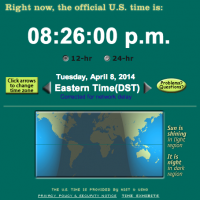What Time Is It? Check the New NIST-F2 Atomic Clock

“Does anybody really know what time it is? Does anybody really care?”
With apologies to the band Chicago, yes and yes. There is a new atomic clock that is three times more accurate than the previous one, and if you want to verify your own clocks right now, here’s the official US time.
The U.S. Department of Commerce's National Institute of Standards and Technology (NIST) recently introduced the newest atomic clock, called NIST-F2, as a US civilian time and frequency standard. According to the International Bureau of Weights and Measures located near Paris, the NIST-F2 US atomic clock is now the world's most accurate time standard. Under development for more than a decade, the new atomic clock will neither gain nor lose one second in about three hundred million years.
What is the importance of timekeeping via an atomic clock? The high accuracy of atomic timekeeping is part of the basic infrastructure of our lives. For example, the NIST official time is used by GPS systems, our mobile phones and computers, and the electric power grid. It’s also used to time-stamp hundreds of billions of dollars in US financial transactions every business day.
According to the announcement, “NIST time is also disseminated to industry and the public through the Internet Time Service, which as of early 2014 received about 8 billion automated requests per day to synchronize clocks in computers and network devices; and NIST radio broadcasts, which update an estimated 50 million watches and other clocks daily.”
"If we've learned anything in the last 60 years of building atomic clocks, we've learned that every time we build a better clock, somebody comes up with a use for it that you couldn't have foreseen," says NIST physicist Steven Jefferts, lead designer of NIST-F2.
For now, NIST will simultaneously operate both NIST-F1 and NIST-F2 clocks. The clocks use a "fountain" of cesium atoms to determine the exact length of a second. For more information on this most accurate timekeeping methodology, here’s the background on how NIST-F2 works.

